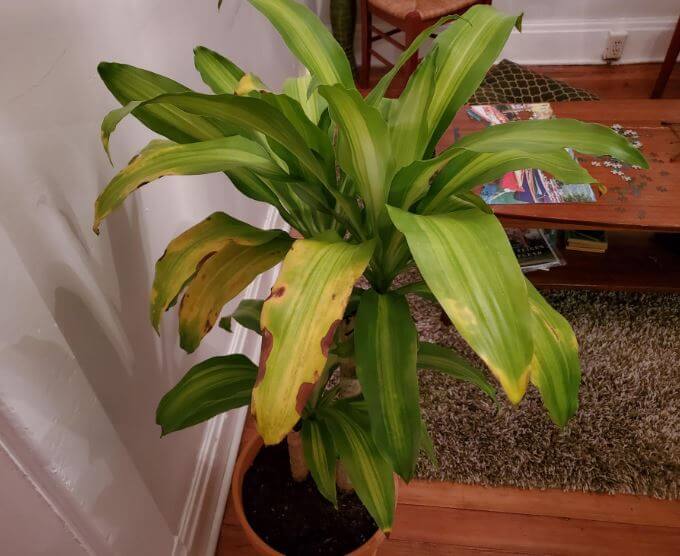Last Updated on June 15, 2023 by a Friendly Gardener
Dracaena plants are striking impressive and very popular houseplants regardless of the variety. However, like all indoor plants, the Dracaena genus plants are susceptible to issues that can cause foliage to turn yellow or brown, perhaps both.
Why Are My Dracaena Leaves Turning Yellow and Brown?
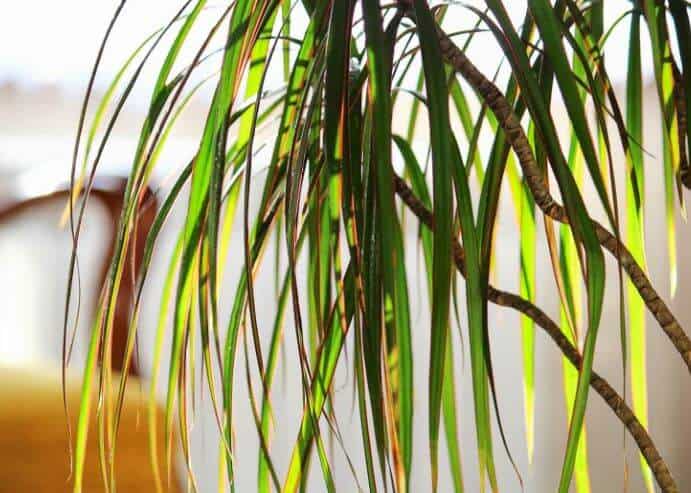
When dracaena leaves turn yellow or brown, there’s no need to jump to conclusions as there can be multiple causes that account for dracaena leaves turning yellow and brown. Problems with lighting, soil, humidity, pests, fertilization, watering, and more can be the origin of leaf discoloration.
The most common reasons for a change in foliage color include:
- Natural aging
- Improper lighting
- A buildup of salt in the soil bed from fertilization
- Sudden temperature changes
- Insect infestations
- Water quality
- Overwatering or underwatering
- Inadequate humidity
Some of these issues can do more than just change leaf colors. They can lead to stunted growth and if left untreated can be fatal. Here we examine the principal motives why your Dracaena plant’s leaves are turning yellow or brown.
Improper Light
If a Dracaena plant is subjected to incorrect lighting conditions, foliage can easily turn yellow or brown. They need generous amounts of bright, but indirect light. Direct sunlight will scorch Dracaena leaves. Inadequate light will cause leaves to yellow and wilt.
What to Do
This is an easy issue to resolve. Simply move your plant to a spot with proper lighting conditions.
Improper Watering Schedule
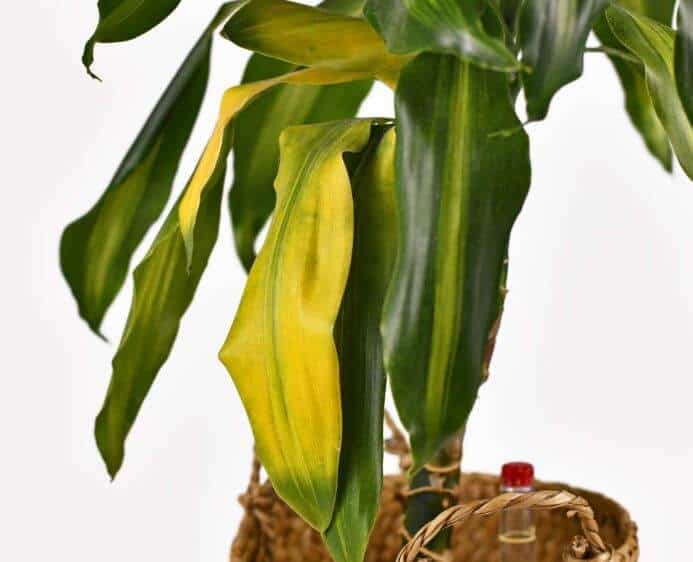
Improper watering, whether excessive or insufficient can lead to Dracaena foliage turning yellow or brown. This is one issue that is not limited to foliage color, it can cause severe problems for the health and survival of your plant.
Excessive watering is the more common watering problem to afflict Dracaena species. Overwatering results in waterlogged or soggy soil beds which in turn are the ideal environment for fungal infections to develop within the soil and attack roots. Left untreated, this condition will lead to root rot and be lethal.
Look for limp and wilting soft leaves among symptoms. Examine the root ball. If roots appear darkened and mushy, perhaps emitting a foul smell, root rot has begun, and you will need to act quickly.
What to Do
Remove the plant and trim off infected roots. Rinse the root ball and treat it with a fungicide. Repot the plant in freshwater and wait several days to water again.
Underwatering is a minor problem. The soil bed will dry out and leaves may turn brown and crispy.
Check the soil bed for moisture approximately three inches deep using your finger. If it feels dry, water your plant. In proper environmental conditions, dracaenas should be watered once a week to every five days.
Low Humidity
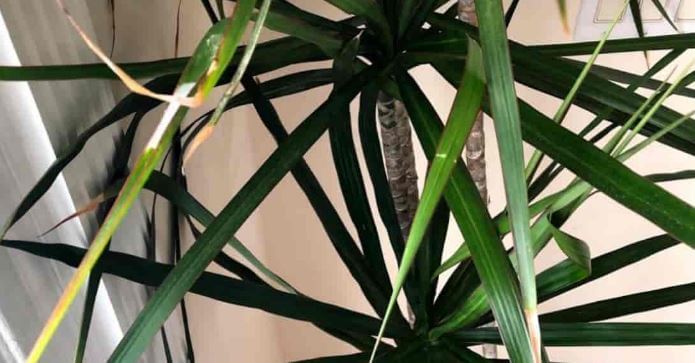
Dracaena plants prefer high humidity. When indoor humidity is too low, these plants will suffer. Foliage will generally begin to droop and eventually change color beginning at leaf edges. Leaves will then turn yellow and afterward brown due to dehydration. Finally, the foliage will shrivel up and drop. If you note these symptoms, you most likely have a humidity problem. Low humidity should be taken seriously as it will affect the entire plant.
What to Do
You can move your dracaena to a bathroom or kitchen where humidity levels are usually higher. Other solutions include introducing a space humidifier, inserting a pebble tray beneath the plant, or misting your plant often. Misting should be done every other day if this is the chosen solution. grouping plants will also help as this creates a microclimate through plant transpiration.
Fertilization and Salt Buildup
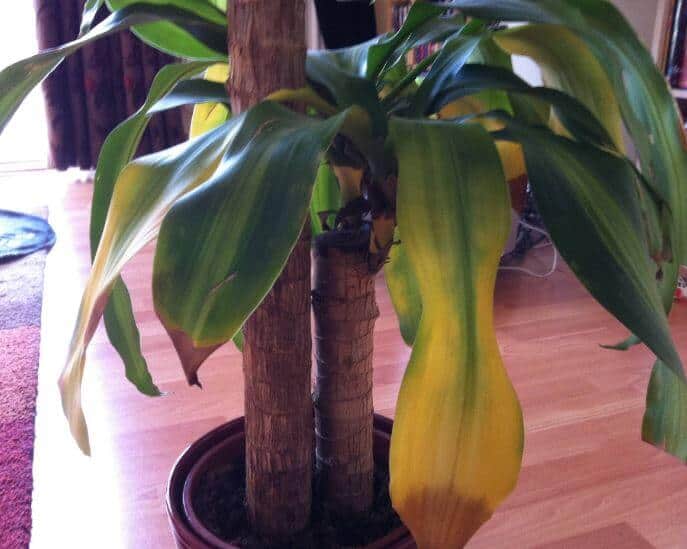
Salt buildup in the soil will cause foliage to turn yellow or brown. This kind of buildup is usually the result of fertilization, especially if the fertilizers you choose contain phosphates that contain more salt.
When selecting a fertilizer, look for a balanced liquid option and prepare one-half of the suggested amount, diluting it in water. Feed your plant from spring through mid-fall when the plant is still in its growing season.
What to Do
If salt buildup appears to be the problem, flush the salts out of the soil bed by pouring filtered, distilled, or rainwater through the soil permitting all excess water to drain through the container’s drainage holes.
Pest Infestation
Pests can cause leaves to turn yellow or brown. If other care issues weaken your plant, this will make it more susceptible to pest problems. Spider mites, mealybugs, or scale insects can all create problems for your plant. These are sap-sucking parasites that will drain your plant of necessary nutrients.
What to Do
Place your plant outdoors or in the shower and wash it using a jet spray to remove most of the pests present. Prune any damaged leaves and treat your Dracaena with an insecticidal soap spray. Once dry, apply a Neem oil spray as prevention.
Sudden Changes in Environmental Temperatures
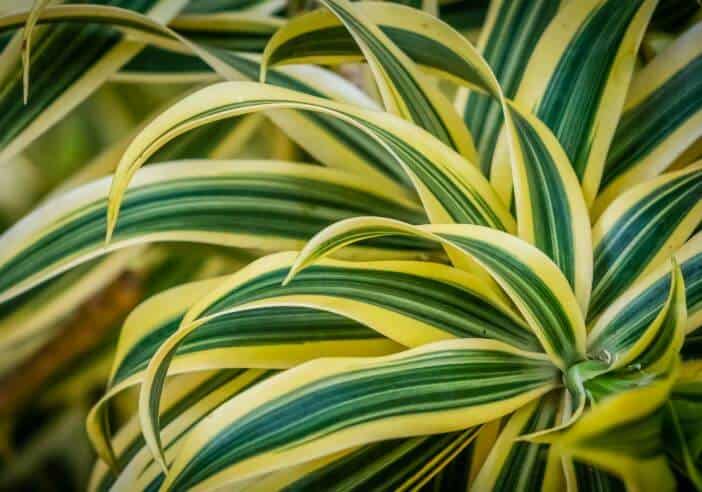
Dracaena plants also suffer when subjected to sudden changes in environmental temperatures. An abrupt increase or decrease can cause foliage to turn yellow or brown. Their preferred temperature range is 70° to 80° F. They are particularly at risk of cold drafts.
What to Do
Monitor the room temperature, even in the evening. Keep plants away from air conditioning units and heating vents. Beware of drafty windows, doorways, or corridors. In the summer, consider moving your plant back from the window if the heat increases.
Water Quality
Dracaena species are sensitive to water quality. They are highly sensitive to chlorine and fluoride, two common chemicals found in municipal tap water. These chemicals can build up within the plant’s soil bed and will be toxic with foliage turning yellow or brown.
What to Do
Avoid watering with tap water. Collected rainwater is ideal if possible. If you cannot use rainwater, filtered, distilled, or bottled water will do fine. If you have no other option but to use tap water, leave the water out for 24 hours so that the chemicals will dissipate with evaporation.
Conclusion
It’s important to remember that dracaena leaves turning yellow may be a natural result of aging. As new growth emerges, older leaves will yellow. This will usually begin with lower leaves. If you have checked environmental conditions and care procedures and there seem to be no other issues, it may be simple aging.
If you see your Dracaena plant’s leaves beginning to turn yellow or brown, run through our list of potential causes and solutions to resolve issues for your lovely plant.

